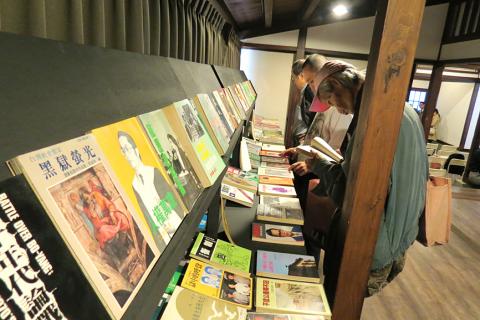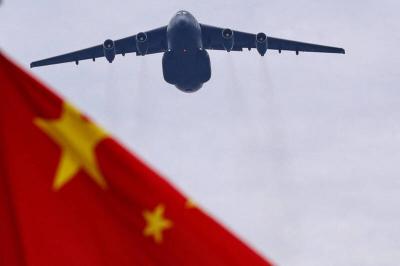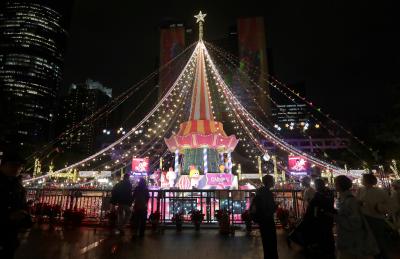The Taichung Civil Affairs Bureau on Monday opened a special exhibition of 300 best-sellers that were banned by the former Chinese Nationalist Party (KMT) government.
The exhibition at the Taichung Literature Museum is as part of the city’s human rights and culture festival, and features books from author Liao Wei-min’s (廖為民) private collection.
Visitors can see well-known works, such as Jin Yong’s (金庸) The Legend of Condor Heroes (射雕英雄傳), which is widely considered a classic of the martial arts genre and one of the greatest commercial successes in modern Chinese-language fiction. The book is displayed in “the ridiculously banned books” section.

Photo: Su Meng-chuan, Taipei Times
Exhibition organizer Chen Yan-pin (陳彥斌) said there is no agreed upon explanation for why Jin’s historical fantasy was banned.
One hypothesis is that the title contains the word diao (鵰), a bird that also appeared in a line of late Chinese leader Mao Tze-tung’s (毛澤東) poem about Genghis Khan; another is that because Jin’s Hong Kong-based newspaper Ming Pao expressed views that offended KMT leaders at the time, Chen said.
Many books that touched on the political climate of the time were banned by censors, such as Long Live the Election (選舉萬歲), a story about civil unrest in Taoyuan in 1977 that was sparked by allegations of ballot-fixing, Chen said.
However, books were also banned because of the author’s political engagements in person or by association, such as The History of Taiwanese Animals (台灣動物史話), which was banned because its author, Liu Feng-sung (劉峰松), was the husband of dissident-turned-politician Wong Chin-chu (翁金珠), Chen said.
“From a modern perspective, it might seem incredible that books like The Legend of Condor Heroes were banned, but the banning of Jin’s book shows the absurdity of the authoritarian period’s preoccupation with imprisoning the minds of Taiwanese,” he said.
Liao, who worked for the Taichung Books and Journals Publishing Co and Humanity Magazine (人間雜誌), said censorship of literature started in 1978, when censors seized copies of Long Live the Election before they could be bound.
About a dozen titles were banned from circulation annually until 1987, when censorship was eased with the lifting of martial law, but it did not end until August 1992, when the Taiwan Garrison Command was disbanded, he said.
Liao said he voraciously bought banned books during the Martial Law era because he felt obliged to “keep the fire of Taiwanese thought” alive, and he often received “invitations to chat over tea or coffee” by the Taiwan Garrison Command as a result.
“We should treasure the rights and freedoms that we now enjoy,” Liao said.
The exhibition is organized by subject, such as proscribed books or rare books, with a section dedicated to works edited or authored by democracy movement pioneer Deng Nan-jung (鄭南榕), who died after setting himself on fire on April 7, 1989.
The exhibition runs until April 16, organizers said.

Beijing could eventually see a full amphibious invasion of Taiwan as the only "prudent" way to bring about unification, the US Department of Defense said in a newly released annual report to Congress. The Pentagon's "Annual Report to Congress: Military and Security Developments Involving the People's Republic of China 2025," was in many ways similar to last year’s report but reorganized the analysis of the options China has to take over Taiwan. Generally, according to the report, Chinese leaders view the People's Liberation Army's (PLA) capabilities for a Taiwan campaign as improving, but they remain uncertain about its readiness to successfully seize

Taiwan is getting a day off on Christmas for the first time in 25 years. The change comes after opposition parties passed a law earlier this year to add or restore five public holidays, including Constitution Day, which falls on today, Dec. 25. The day marks the 1947 adoption of the constitution of the Republic of China, as the government in Taipei is formally known. Back then the Chinese Nationalist Party (KMT) governed China from Nanjing. When the KMT, now an opposition party in Taiwan, passed the legislation on holidays, it said that they would help “commemorate the history of national development.” That

Taiwan has overtaken South Korea this year in per capita income for the first time in 23 years, IMF data showed. Per capita income is a nation’s GDP divided by the total population, used to compare average wealth levels across countries. Taiwan also beat Japan this year on per capita income, after surpassing it for the first time last year, US magazine Newsweek reported yesterday. Across Asia, Taiwan ranked fourth for per capita income at US$37,827 this year due to sustained economic growth, the report said. In the top three spots were Singapore, Macau and Hong Kong, it said. South

Snow fell on Yushan (Jade Mountain, 玉山) yesterday morning as a continental cold air mass sent temperatures below freezing on Taiwan’s tallest peak, the Central Weather Administration (CWA) said. Snowflakes were seen on Yushan’s north peak from 6:28am to 6:38am, but they did not fully cover the ground and no accumulation was recorded, the CWA said. As of 7:42am, the lowest temperature recorded across Taiwan was minus-5.5°C at Yushan’s Fengkou observatory and minus-4.7°C at the Yushan observatory, CWA data showed. On Hehuanshan (合歡山) in Nantou County, a low of 1.3°C was recorded at 6:39pm, when ice pellets fell at Songsyue Lodge (松雪樓), a